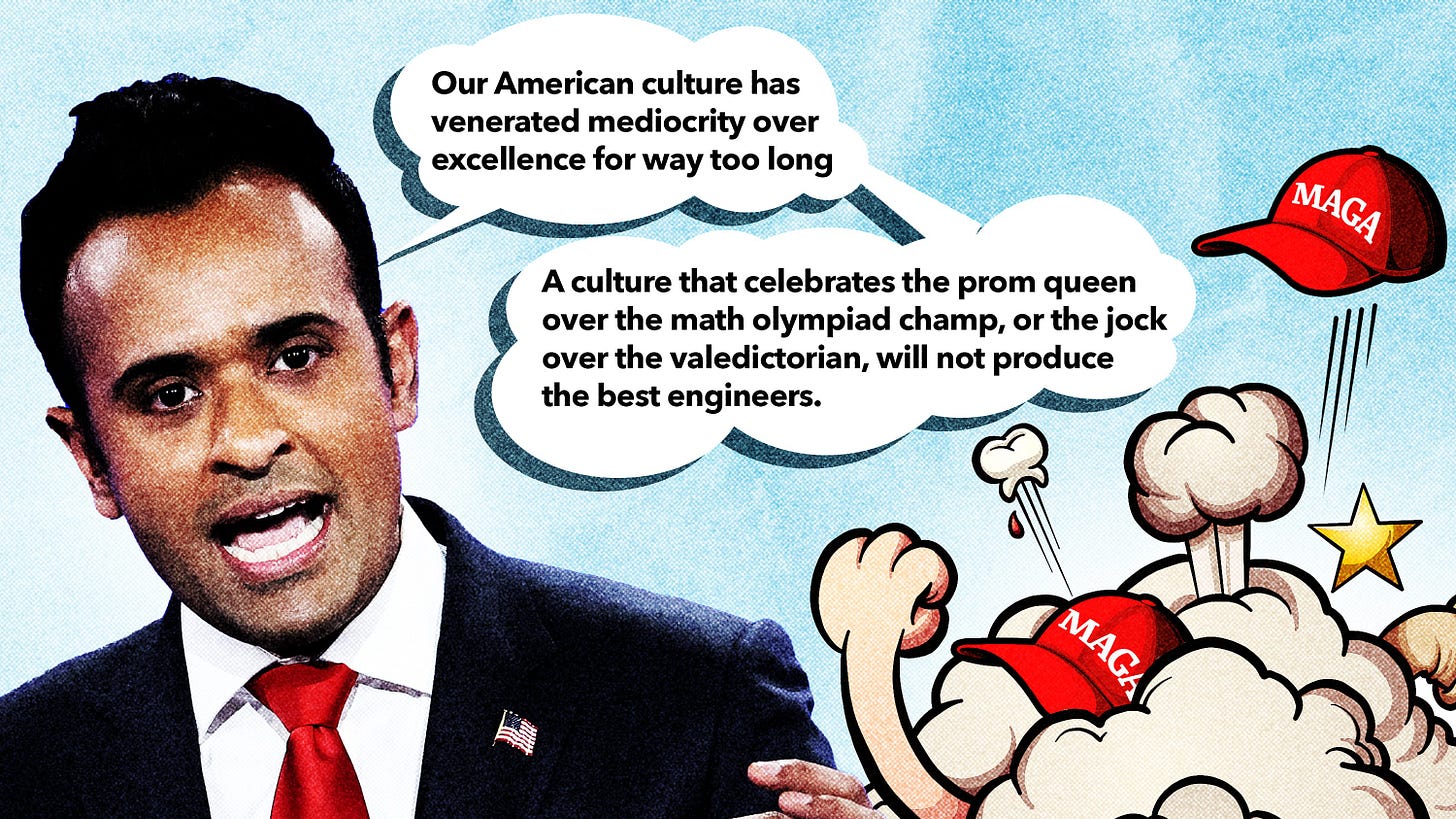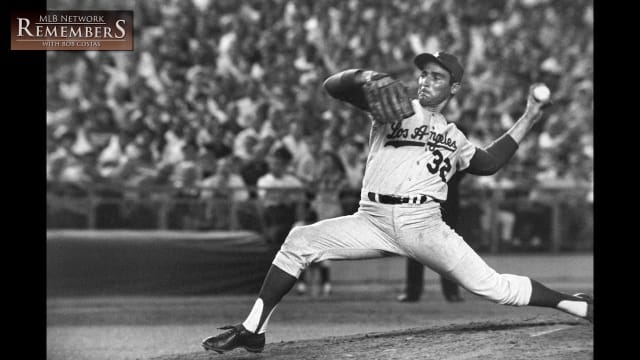Yesterday, in Part I of Balaam’s Ass, I delved into the character of Elon Musk. I didn’t like what I found. Big Space Daddy1 turned out to be a huckster, a fraud, and a weirdo, pure and simple.
Today, I’ll turn my attention to the other member of the DOGE tag team, Vivek Ganapathy Ramaswamy, the pride of Cincinnati2. Actually, I’m not going to expose anything about him personally, I’m going to analyze the responses to what he said.
Vivek got pounded for Xweeting about prom queens and Olympiads and sleepovers by the alt-right/groyper/groyper-adjacent wing of MAGA.
Some saner, more rational people, pushed back as well, which I’ll circle back to.
The argument is ongoing and will play out in coming years.
Friends, Vivek didn’t say anything about American society that wasn’t said in even more vitriolic words from the 1920s to the 1960s. America-bashing was once as American as apple pie.
During this Golden Age Of American Self-Hatred, there were two types of anti-American snobbery: the first, which views American society as inherently shallow, vulgar, and unredeemable, and the second, which criticizes America not for its materialism, but for embracing the wrong kind of materialism (sports, beauty pageants).
Mencken was the greatest practitioner of the first camp: America as irredeemably vulgar to its core. In his 1922 essay On Being an American, Mencken wrote: “The American people, as a whole, are probably the most timorous, sniveling, poltroonish, ignominious mob of serfs ever gathered under one flag in Christendom since the end of the Middle Ages.” Mencken frequently mocked Americans for valuing superficiality over intellectual rigor, railing against their obsession with entertainment and materialism. According to modern scholarship, he did so as a proud German-American, to which I’ll return in due course.3
The entire career of the now nearly-forgotten Sinclair Lewis, once a best-selling author (and winner of the Nobel Prize for Literature and a Pulitzer) , was dedicated to skewering middle America for its superficial values. His books regularly criticized how communities idolize sports heroes and local beauty queens while ignoring serious intellectual or economic issues. In his small-town America, spectacle and popularity outweighed substance.
Pretty much every other notable American writer of the pre-War era portrayed America similarly: vulgar, shallow, grasping.
Sigmund Freud reportedly said to his colleague, Ernest Jones, “America is a mistake, a giant mistake.”
We survived.
In the second camp, no one can outdo Philip Wylie for sheer nastiness unredeemed by a morsel of sympathy for the objects of his derision. His 1942 book Generation of Vipers was a biting critique of American culture. He wrote: “We’ve turned high schools and colleges into training camps for athletes and popularity contests for prom queens, while the rest of the world races ahead in science and technology.”
Wylie is an especially interesting character. Born in Beverly, Massachusetts, to a Presbyterian minister and a novelist mother, he was a perfect scion of the WASP elite of that era. From the 1930s through the 1950s, he was one of the most prolific and influential writers in America. He wrote novels, short stories, articles, screenplays, and even newspaper columns. Some of his works, like When Worlds Collide and Gladiator, have had lasting impacts on popular culture, but he himself is largely forgotten and his social commentary has fallen into the memory-hole.
“Momism,” became a buzzword in the 1950s:
Stay-at-home mothers were often portrayed as an even bigger menace to society than career women. In 1942, in his best-selling “Generation of Vipers,” Philip Wylie coined the term “momism” to describe what he claimed was an epidemic of mothers who kept their sons tied to their apron strings, boasted incessantly of their worth and demanded that politicians heed their moralizing.
Momism became seen as a threat to the moral fiber of America on a par with communism. In 1945, the psychiatrist Edward Strecher argued that the 2.5 million men rejected or discharged from the Army as unfit during World War II were the product of overly protective mothers.
The Greatest Generation wasn’t thought of as great during the 1940s:
In the same year, an information education officer in the Army Air Forces conjectured that the insidious dependency of the American man on “ ‘Mom’ and her pies” had “killed as many men as a thousand German machine guns.” According to the 1947 best seller “Modern Woman: The Lost Sex,” two-thirds of Americans were neurotic, most of them made so by their mothers.
Here you have it: Americans in the past routinely suffered what we would now call abuse from prominent social critics.
So what accounts for the fragile high-dudgeon indignation to Vivek?
I shy away from sweeping generalizations. I can only offer a few conjectures.
People think of the 1960s as the beginning of bitter criticism of American society. It would be more accurate to say that it was the end. Criticism became associated in the popular mind with a catastrophic military defeat. If you criticized America you were (and usually were) a leftist traitor.
There is also the massive increase in foreign-born persons in the US, which is greater now than any time in US history. Many come from non-European, non-Christian backgrounds. This increases the feeling of being a besieged (shrinking) majority.
I’m not even going to go into the whole other nine yards: DEI, “color-blind casting,” and open, enthusiastic demonization of whites. But it’s important, lurking over the conversation like smog. It can’t be excluded from the conversation.
Americans suspect that Vivek is speaking not as an American of Indian origin but as an agent of India, as Sriram Krishnan was obviously speaking here: “Anything to remove country caps for green cards / unlock skilled immigration would be huge.”
When an emigration cohort becomes large and coherent enough to place a foothold in the new society, it’s natural to look at the characteristics they bring from the natal culture.
Where Indians go, they bring caste.4
Ah, caste, yes, that little thing. Ramaswamy is not merely Indian, he’s a Tamil Brahmin, the highest caste in India. Both parents were prosperous professionals. Every other technogarch comes from the same background: Tamil Brahmin. Or some other kind of Brahmin.
Someone whose parents benefited from 3,000 years of preferential treatment ought not to lecture about the inferiority of the culture that his parents freely chose to come to5.
The overwhelming majority of white Americans descend from people who were disfavored in the old country. The whole point of uprooting oneself was to get away from persecution or poverty. They didn’t fly here; they came steerage. Peasants, manual laborers, shtetl-dwellers. They worked in coal mines and steel mills, and factories under miserable conditions. They died in industrial accidents.6
David Brooks actually wrote something decent if a bit weak tea about this. (Well, it is David Brooks, the king of weak tea.) We both come from backgrounds that are sort of in the Vivek camp — Jewish culture.
I did imbibe a slight contempt for American cheerleading/prom culture that Vivek disdained while growing up…
Yet… American culture isn’t just inanity like proms and cheerleading, it’s the whole seductive ball of wax: the Knicks, the Mets (or whatever your home team is), music (roots, blues, bluegrass, country, opera, jazz, rock, symphonies), movies, theater, literature. And nature. And the Constitution. History — our history. America is jam-packed with history. It’s natural for a kid to wonder about that.
Who were our idols growing up?
Hold on. I have a story to tell you.
When Obama was in the White House, he had one of those cringey ethnic pride celebrations. Who came? The usual: politics, law, money.
Who did he talk about? Who did anyone care about?
Sandy Koufax.
Obama:
This is a pretty -- pretty fancy group here, pretty distinguished group. We've got senators and representatives. We've got Supreme Court justices and successful entrepreneurs, rabbinical scholars, Olympic athletes — and Sandy Koufax. (Applause.)
Yup — a pretty fancy group, pretty distinguished group. Let’s hear that again: senators, representatives, justices, entrepreneurs, athletes — and Sandy Koufax.
It was all about Sandy.
Obama couldn’t have cared less about any of them except Sandy.7
Would you? I wouldn’t. Here are some pictures of Koufax pitching, just because…. Because it’s so American. If I have to explain it to you, you wouldn’t get it.
Barack: we hear you. On this, we are as one.
Vivek: America will win. We survived Mencken and Wylie, we’ll survive you.
At the end of the day though, numbers matter. Just as H.L. Mencken’s beloved Germans influenced American due to sheer numbers and cultural power, and WASPs gave way to the post-war Ivy Jewish cognitive elite, an imported class of Indians will influence American culture, especially if they join the Silicon Valley techogarchy in massive numbers.
It shouldn’t be against the rules to point this out.8
*I had to give this post a different name than Part I.
Thanks to Shannon for inspiration. I was thinking of calling him Big Daddy, inspired by Burl Ives’ immortal portrayal of that character in Cat On A Hot Tin Roof. She suggested Space Daddy in a Xweet. Great minds, voila: Big Space Daddy.
That, not India, is his birthplace.
Regarding Mencken’s attitudes towards other groups, I will not comment here as the subject is beside the point.
“…if Hindus migrate to other regions on earth, Indian caste would become a world problem.” CASTES IN INDIA: Their Mechanism, Genesis and Development by B. R. Ambedkar, Paper presented at an Anthropology Seminar, taught by Dr. A. A. Goldenweiser, Columbia University, 9th May 1916. (There’s a bust of Dr. Ambedkar in Columbia U, which I’ve seen.)
But not become citizens of: Vivek’s father chose not to become a citizen “for family reasons.”
Apologies to foreign readers who don’t know what I’m getting at here: Sandy Koufax is one of the greatest pitchers even to pick up a baseball. Ernie Banks, who hit 512 home runs, said: “In the end, you knew you were going to be embarrassed. You were either going to strike out or foul out.”
The top three castes in India total 450 million people.




